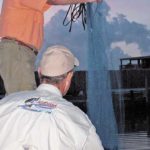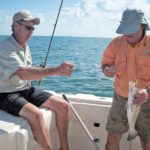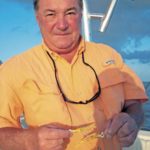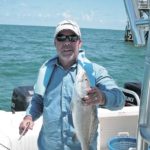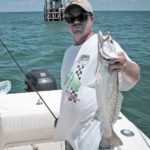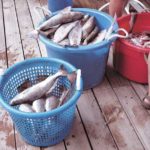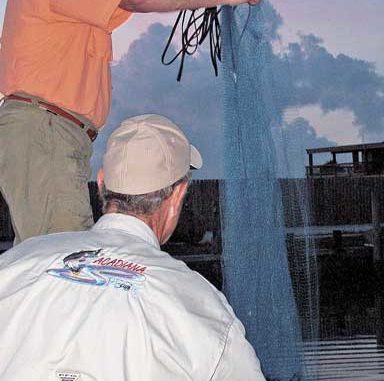
During the summer months, when the specks are big and hungry, these three go together like ice cream, hot fudge and whipped cream.
Huey Olivier’s well-equipped World Cat left Cypremort Point shortly after sunrise more than ready for a day of catching big speckled trout at close-in oilfield rigs in the Gulf of Mexico.
Before one of the dozen or so fishing rods aboard was cast, before one hook was set, the skipper had prepared himself for success.
Sure, Miss Lil was headed to a happy hunting ground for speckled trout — Eugene Island 74. But the fact everything was there in place was a tell-tale sign for a crew that included his good friend Johnny Martin of Breaux Bridge, a local outdoor writer and his son Jacob Shoopman of New Iberia, and the outdoor writer’s visiting brothers Bill Shoopman of Kansas City, Mo., and Keith Shoopman of Belton, Mo.
There were 250 live cocahoes and dozens of live mullet swimming in two bait tanks at the stern, just in front of the two softly humming 300-horsepower Suzukis.
There were pre-rigged 1 1/2-foot-long 20-pound leaders for Carolina-rigging the live natural bait, some on No. 1 kahle hooks for the cocahoes, some on No. 3 kahle hooks for the mullet because, Olivier said, the mullets’ heads are larger.
Miss Lil was armed to the teeth, too, with 35-40 tandem-rigged 3/8-ounce leadheads for the various soft plastics. They were loaded on three soft rubber rollers with grooves for the hook points to be imbedded.
The leaders and tandem-rigged leadheads were made up the night before. No wonder the Miss Lil returned about 12 hours later with a long icebox crammed with 2- to 4 1/2-pound speckled trout.
“You know, when the fish are biting — especially this time of year when the water’s pretty — you’ll have a lot of Spanish mackerel and bluefish, and you break off a lot,” Olivier said. “You can spend all day just rigging up.”
Olivier and Martin depend on both natural and artificial bait, which is why they have setups for both ready in advance.
“You know, we go out there and sometimes we start busting them on plastics,” Olivier said. “All of a sudden they quit. You throw live bait, and they start hitting again. We always have plastics ready.”
Also at the ready during the outing were flippers (for catfish), grabbers (for speckled trout and other fish) and pliers, all on a non-skid surface so they can stay out while the boat goes rig-hopping.
The 66-year-old Olivier, an Arnaudville native who has lived in New Iberia 46 years, bought the World Cat in May, just in time for the speckled trout fishing to get red-hot at the near-offshore rigs he likes to fish so much. He founded Iberia Threading in June 1972, a thriving oilfield-related company turning out tubing and casing before selling it in January 2000. He retired six months later.
Olivier and his wife, Lilias Mason Olivier, have three children, Lisa Olivier Norris, Christine Olivier Norris and Todd Olivier, another avid saltwater fisherman.
Martin, 61, owns Martin Chevrolet Inc. in Breaux Bridge, a family business started in 1927 by his great-grandfather Alcibre Deomingues.
Olivier and Martin, proud members of the Acadiana Speck Club, have been fishing together about nine years. They fish like a close-knit team. Their successful routine, forged over the years, starts long before they leave the boathouse (getting fresh natural bait with a cast net the day before the trip, making leaders for Carolina-rigging and putting together tandem-rigged leadheads for the soft plastics) and doesn’t end after the outing until the speckled trout have been filetted and the boat cleaned spotless.
One of their fishing buddies who didn’t make the trip that particular day but would join them on Martin’s boat for an ASC tournament three days later out of Cypremort Point, said the men are two of the most accomplished and respected saltwater fishermen in the region.
“Huey and Johnny are two of the best. Of course, they get to go a lot. Their time on the water is well spent,” said Jimmy Guidroz, a 56-year-old outdoorsman who works as fleet manager at Hub City Ford in Lafayette. “Huey’s a good fisherman. We all have our own knacks. I fish with (soft) plastics. Huey likes live bait. Johnny’s good with live bait. Huey’s good with positioning the boat, anchoring in the right place, and good with reading the water.”
Guidroz agreed that their preparation seals the deal for productive fishing trips. It’s a big reason the shirt worn by Olivier had Acadiana Speck Club 2006 Champs written below his name.
Olivier, Martin, Guidroz and Brit Bush of Lafayette finished eighth in the ASC tournament with their best five fish weighing 19 pounds, 6 ounces.
Olivier’s favorite fishing hole, one of his many in the northern Gulf, is 29 miles from Marsh Island and 42 miles from his camp at Cypremort Point. He has coordinates punched in for the all of the spots.
“Huey’s the man. He knows where to go,” Martin said.
“We fish out here most of the time — less boats,” Olivier said. “The only time we fish at other rigs is when we’re not catching at these,” he said, sweeping his hand in the direction of Eugene Island 65 and 32.
Travel 15 miles farther south from Eugene Island 74, and the water’s 80 feet deep, Olivier said. Where the Miss Lil was fishing in that part of the Eugene Island field, the depth was 18 to 20 feet, he said.
Martin has been fishing the close-in rigs for about a decade. The key “to fishing out here is good live bait and good water. Good live bait is the biggest thing,” he said.
Waiting until the water’s right, which most of the time doesn’t happen until late spring, is the hardest part for speckled trout fishermen in this area who have been chomping at the bit since late fall and through the winter to get back out in the Gulf.
“This year we started the last weekend of May. It was a little late, the river being so high this year,” Martin said about the Atchafalaya River, which rose to almost 20 feet late this spring at Butte La Rose. “When the river gets down to about 8 feet, the water really clears up over here. We won’t have river water coming in over here. The only thing — when the water clears like this, Spanish mackerel and ladyfish wear it out.”
After about a 1 1/2-hour boat ride in which sandwiches were eaten and fishing rods rigged up by Martin while Olivier steered the Miss Lil, Olivier pointed out Eugene Island 74 “dead ahead” at 7:15 a.m. When the boat arrived, two boats were there by a leg at two corners, and the anglers aboard them alternately hauled in 2- to 5-pound speckled trout.
At the first stop, Jacob Shoopman, who’s a junior at Southeastern Louisiana University, was the first to hook up with a 2-pound-plus speckled trout, followed in short order by his father and then Olivier. A Spanish mackerel, a large stingray and a handful of ladyfish also bit over the next hour or so, but the action far from satisfied Olivier, who started the twin outboards to leave at 9:25 a.m. in search of more productive water.
Olivier pointed the bow south again, and headed to Eugene Island 95. Miss Lil carved through the 2-foot seas for about 15 minutes before arriving at the next destination.
“What about this, Johnny? It’ll work?” Olivier asked Martin as he maneuvered the big boat into a position to drop anchor within casting distance of the oilfield structure.
“It’ll work,” Martin said.
And how.
Bill Shoopman heard the distinctive, loud piercing tone emitting from the oilfield structure, and said, “There’s the dinner bell.”
As if on cue, fish bit from the first cast on.
“Your move paid off,” Keith Shoopman said as anglers started hooking up left and right.
The banter that goes hand in hand with fish biting in a feeding frenzy was in full swing.
Olivier banged the steel hook home, and reeled in a nice-sized speckled trout, all while netting a 1 3/4-pounder for Martin, who was smiling broadly.
“He’s small, though, I’d throw him back,” Olivier said with a good-natured laugh about the smaller fish brought in by Martin.
Martin manned the landing net several times for Bill Shoopman, who seemed to have a knack for bringing in two fish at a time on tandem-rigged chartreuse/red dot soft plastics, something he did at least four times in a short span. He had more multiple hookups, but on several occasions at least one of the two hooked fish managed to come off.
He took Olivier and Martin’s advice to heart while fishing the tandem-rigged soft plastics. Let the hooked fish swim (during the fight), they said, so that the other soft plastic flops and flips around to grab the interest of other speckled trout following the action, which often prompts one of them to grab the unoccupied hook.
The good ol’ boy from Missouri was on Cloud Nine, just like his younger and older brothers and nephew. They listened intently to every fishin’ tip and insight on what was happening being offered by Olivier and Martin, who patiently shared years of speckled trout fishing experience.
The local men were just as excited as the visitors who were enjoying themselves immensely as fishing rods arced and drags peeled under the weight of every solid fish.
It’s the kind of time on the high seas that every fisherman with saltwater in his blood lives for. That would be Olivier and Martin.
“When it gets like this, I go four times a week. I get people to go with me,” said Martin, who is semiretired. He owns a 32-foot Regulator, one just like the boat his fishing buddy Olivier owned before getting the World Cat.
Then Martin looked at the variable chop on the seas and nodded his head in satisfaction.
“It’s not too often we get a chance to come and really catch fish like this on a day like this — weather pretty and calm,” he said.
“With the water like it is today, you can see them when they’re way out there,” he said.
At that moment, Olivier delivered a powerful hookset and another fish was on.
The action got so hot and heavy, eating and drinking were all but forgotten. Martin said as much.
“When you start catching, you forget to eat. All you want to do is keep on catching,” he said.
Martin had a deer hunting camp for years in the Atchafalaya Basin, “right where Butte La Rose and I-10 meet. As a matter of fact, I watched them build I-10.”
But he eventually gave that up in favor of a camp at Cypremort Point. That’s how he met Olivier. They became fast friends and fishing buddies.
“He had a camp next to me before he built this one. Our wives became friends and do everything together. They fish with us. We’ve gone to Costa Rica and done some sailfishing over there,” Martin said.
At the Point, they “cook, fish, socialize” and otherwise enjoy all South Louisiana has to offer along the central coast of the Sportsman’s Paradise.
But Hurricane Rita, which hit to the west in September 2005, was felt at the Point. Olivier showed water lines 2 to 2 1/2 feet above the camp’s foundation from the storm surge that weekend, and said big timbers came in with the water and damaged the wharves.
That was behind them but not forgotten. Martin and Olivier focused on the task at hand, which was to hook and catch speckled trout on live bait and artificials at that second stop.
Martin likes to find out-of-the-way, small oil rigs like the one all on board were fishing. He doesn’t join the maddening crowd at popular reefs near Cypremort Point, like Nickel Reef a few miles southeast of Marsh Island and Tee Butte to the west of Marsh Island.
“I don’t fish the reefs at all. Why go fish the reefs when you catch fish like that?” Martin asked rhetorically in the midst of a 20-minute flurry when nothing but 2 1/2- to 4-pound fish came into the boat consistently.
“When they start biting like that, you’ve gotta keep after them. You slow down, they slow down,” he said.
The sun was high over the water at midday with few clouds in sight. A breeze blowing off the water kept the heat at a minimum.
Speckled trout lifted or swung by landing net into the boat went first into a plastic laundry basket conveniently located in the stern. Martin would punch a lick on his clicker to keep count of the number. When the laundry basket filled up, the fish were dumped into a long, deep ice chest located in the floor of the boat.
“There’s probably 10 fish in the box (weighing) 3, 4 pounds. You talk to most fishermen, that’s 5-pound trout,” Martin said.
Eventually, the wild round of hits and misses subsided to the occasional catch, including lemonfish, bluefish, small sharks, Spanish mackerel and ladyfish. Soon the lulls in the action spaced out longer and longer.
Olivier cranked up and motored to a nearby satellite rig. He shut the outboard motors off, and said, “First one in, first one to get a fish.”
But, at first, only catfish got separated from the hooks. Then Olivier caught a nice speckled trout.
“They’re in there. You’ve just got to get the catfish out of the way first,” Martin said.
The trip ended with 90 speckled trout on ice. It was time to head back.
“That was an average day. It’s fishing. You fish a lot, you know how it is. Sometimes we go and in a couple of hours we catch our limit. Sometimes you have to struggle for them. We don’t know what turns them off, what turns them on.”
Being ultra-prepared certainly helped, and the guests appreciated it.
